The Carbon Story Behind Regenerative Agriculture.
Four years ago, the Pasto Vivo project was born through a partnership with Luxor Agro and the support of consultants from reNature and Preta Terra. Our goal was to transform a conventional cattle operation into a regenerative system on a 1200-hectare cattle farm in Mato Grosso, Brazil. This region sits at the crossroads of Brazil’s agricultural hotspot, facing significant threats from deforestation as it transitions between the Cerrado biome and the Amazon.
The start of the project was mostly about building key infrastructure and addressing the life quality of the families living in the farm. A new housing project was built and basic infrastructure to attract the talent we needed to lead the project was established. Including hiring Leandro Domiciano, a manager with a hands-on farm operation background, combined with a PhD in agroforestry systems, who took on the challenge to live in the farm and lead the project.
Initially, our aim was to develop an integrated agroforestry system that could produce alternative proteins alongside animal protein, thus shifting the focus from cattle as the main driver of deforestation to using them as agents of soil regeneration. Through trial and error, we transitioned from a complex, high-cost design to a more efficient version, aiming for larger-scale implementation at around USD 500 per hectare. Our overarching objective has always been to strike a balance between management practices and inputs to regenerate soils, restore biodiversity in protected areas, and create ecological corridors connecting these zones.
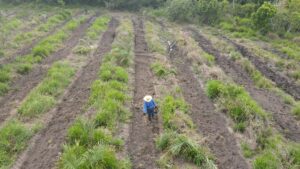
As we integrated cattle with the agroforestry system, the soybean frontier rapidly expanded into our region and Luxor’s larger operation. This prompted us to take on a larger challenge: the full transition to regenerative agriculture across Luxor’s entire portfolio. Our primary concern was whether two key agricultural commodities, which currently drive deforestation, could be produced within a regenerative system. To address this question, we hired our own Chief Regenerative Officer to work with the support from top-tier Brazilian universities such as the University of São Paulo, Unicamp, and Wageningen University in the Netherlands. Our first task was to develop a robust impact monitoring framework to guide our transformation. A protocol capable of measuring the effects of our production systems on soil health, biodiversity, water quality and carbon sequestration. In a world where the value of ecosystem services is often measured solely in terms of carbon, we commissioned a reputable company to conduct a carbon assessment of our operation during the transition phase and projected its state after ten years when the transition is complete.
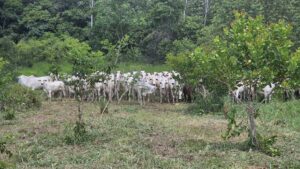
The findings of the assessment provide hope and validation that we may indeed be on the right track towards a significant impact. Our initial farm, São Benedito, where we started the Pasto Vivo project is already carbon negative. We achieved this with more than 70 hectares of agroforestry implemented, in addition to restored native forests. Another key factor is the improvement of livestock management, which we have carried out under the guidance of the Savory Institute. In practice, a well-managed livestock rotation promotes greater health of pastures and soil, resulting in increased soil carbon content and greater CO2 removal.
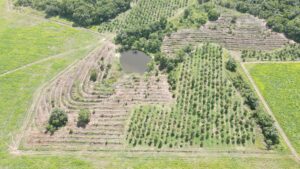
Furthermore, despite the large operation of cattle integrated with soybeans currently emitting close to 14,000 tons of carbon equivalent and sequestering only close to 4,000 tons of CO2 equivalent, we can turn the balance around to net zero with the full transition. Even with increased grain and cattle production, the scenario for 2032 shows emissions of close to 30,000 tons of CO2 equivalent balanced by the sequestration of slightly over 30,000 tons generated by 2,700 ha of agroforestry pastures under holistic management, 700ha of pastures converted into forest reserves and ecological pathways as well as more than 4,000 ha of integration of grains and pastures with regenerative practices.
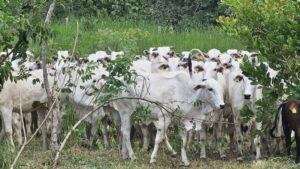
When it comes to coffee production, the carbon story is even more compelling. We anticipate transitioning from a farm with net positive emissions to one that serves as a significant carbon sink once fully integrated into an agroforestry system.
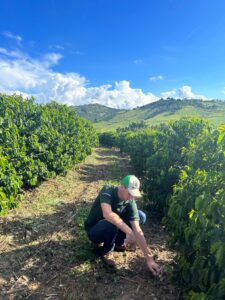
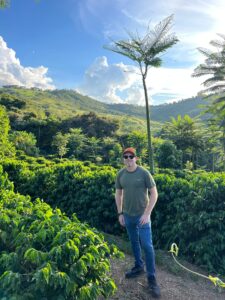
Overall, our experience underscores the potential of regenerative agriculture to not only sequester carbon but also to enhance water resources and biodiversity, as we intend to prove with our monitoring protocol, highlighting the importance of our food system transformation to address our climate crisis. Further impact can be achieved as we shift consumption and supply chains, but if net zero can be achieved in large scale operations of conventional commodities such as soybeans and beef, imagine what can be done when we shift to a more diverse production system including more food that grows on trees.
As we speed up the pace of transition in the larger farm we have plans to convert the farm where it all started, São Benedito, into a training center. The goal is to expand holistic grazing and the agroforestry design to neighbor farms raising calves, so we can also address our scope three emissions and the challenge of having a fully integrated supply chain of deforestation free cattle.

